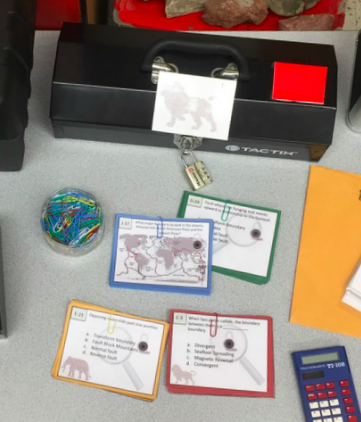ESCAPE ROOMS ARE PERFECT FOR COLLABORATION
Use Escape Rooms to teach content and much more.
Escape Rooms are a perfect activity for cultivating collaboration in the classroom. Many activities are simple and do not require students to work together. Unlike many other activities, escape rooms are very complex. Many escape rooms are layered with specific content information as well as puzzle solving challenges. In addition to “content specialists” and “puzzle solvers”, students also have the opportunity to shine as “specialists” within a collaborating group of students.
ESCAPE ROOMS ARE COMPLEX
Many escape rooms are multi-tiered, and have several challenges designed to force outside of the box thinking. In one escape room that we will examine, the students are divided into three groups and given the challenge of opening a series of lock boxes, which eventually lead to a coveted homework pass. The first challenge that the students are faced with is a twenty-word vocabulary puzzle. The students are given a page that is split into twenty sections. Each section contains a definition to a term. The students also receive twenty matching term tabs. The students place the correct term on correlating definitions. Each tab also contains a number. When the tabs are placed correctly, the numbers, when deciphered match a five-digit combination to a lock. The combination opens the first lock box that contains each team’s clue cards.
CONTENT KNOWLEDGE IS REQUIRED
After each team opens the initial lock box, and retrieves their clues, the race is on to retrieve the homework passes. The three teams involved are identified by color and a mascot. The yellow teams are the elephants. The red team is the lions, and the green team is the dogs. Each team’s cards are color coded, and have a written clue with four multiple-choice answers. When the clue is read, the team collaborates to choose the best answer. Each letter and answer is recorded on a provided answer sheet. The presents of content knowledge within the escape room allows certain individuals to share what they know, and explain their answers to the group. The answers to each question will eventually allow the students to open all of the subsequent lock-boxes and retrieve the homework passes. The catch to the escape room though is that content knowledge is only a fraction of completing the challenge.
ESCAPE ROOMS DEMAND PROBLEM SOLVING SKILLS
In addition to content knowledge, each group involved in solving the escape room challenge must also use provided ciphers to decode combination locks. These ciphers may be viewed as a type of Rosetta stone that the students must use to crack each lock-box. In our escape rooms, the ciphers are representations of Egyptian Hieroglyphics. Because of the mysterious past that the Egyptian culture conjures within the student’s mind, the theme is a natural fit to use within the context of an escape room. The first cipher the students must use is composed of several hieroglyphics mixed with arrows, addition symbols, and division signs. The pictures represent the twenty-vocabulary terms correlated numbers being added in their respected rows and also divided by a given number. The cipher acts as a convoluted road map of instructions for the student on how to derive a five-digit combination used to unlock the first of several lock-boxes.
After opening the initial clue card, lock box, the students must accumulate the correct content answers, but perhaps more difficulty is experienced in deciphering the a’s, b’s, c’s, and d’s into combinations used to open the locks. The second cipher provided to the students, shows the relationship between the multiple-choice letters, as they are represented by Greek letters and correlating numbers. In addition to the number cipher, a mascot cipher is provided that the students must also make sense of in order to unlock subsequent lock-boxes. In many cases, the students who become master decipherers are not the same students that have mastered the content. This allows for multiple leaders to emerge within the group.
THERE ARE TASKS FOR ALL STUDENTS
In addition to students who love the content, and the students who enjoy solving puzzles, there are other responsibilities that require a collaborative effort to become successful with the escape room. The detail-oriented students are the best fit to write down the answers onto the answer sheet. If any of the answers are transcribed incorrectly, the locks simply will not open. Making an error in transcribing the letters and numbers may cost the team valuable time. This time can become invaluable due to the time limit that you may place on the challenge.
Within the escape room challenge, recognizance missions can play key roles in a group’s success. The “recon” specialists keep their eyes and ears open for any clues that the opposing groups may allow them to overhear. In many of the escape rooms, “fast forward” tickets are hidden within the classroom or in a side lock-box. If one group begins to pull away from another, students may take on the job of finding fast forward tickets. These peripheral challenges allow additional students to become involved in the success of the group.
STUDENT COLLABORATION & TEACHABLE MOMENTS
At the end of the day, escape room activities provide both, a great way for your students to collaborate, and a perfect opportunity for teaching moments to occur in your classroom. Due to the many moving parts of the escape room, including fluctuations of what team is in the lead, or which is finding a way to succeed in the challenge, students who do not usually work together, find themselves interwoven in a common cause of unlocking the homework pass lock-box. In addition to student collaboration, teachers are given many opportunities to provide guided instruction.

